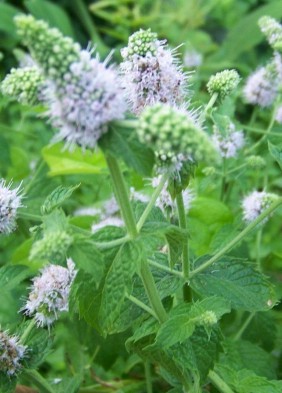 Mint
is an invasive
perennial herb that sends up new plants
from the spreading roots. It has the distinctive square stems common
to most of the mints, but interbreeds readily, making it difficult at times
to determine the exact species. Most mints are native to Europe and
Asia, but mint has naturalized throughout North America.
Mint
is an invasive
perennial herb that sends up new plants
from the spreading roots. It has the distinctive square stems common
to most of the mints, but interbreeds readily, making it difficult at times
to determine the exact species. Most mints are native to Europe and
Asia, but mint has naturalized throughout North America.
Mint is important commercially as a source of flavor and menthol.
Peppermint is used widely in chewing gum, candy, and other sweets, but is
too strong for most other home culinary uses. However, it can
be used to make tea and garnish fruit drinks, etc. True Peppermint
is a sterile hybrid, and does not produce seeds. The plant must be
propagated by cuttings, divisions, or layering.
Spearmints are milder and more versatile culinary mints. They compliment
all kinds of meat, fish and vegetable dishes. They are excellent combined
with just about any vegetable, and in soups, peas, sauces, candy and
chocolate.
Apple Mint has a slightly fruity flavor and is good for garnishing drinks
and adding flavor to fruit salads, cream cheeses and cottage cheese.
Mints spread rapidly, and can be used as a fragrant
Ground Cover,
but their growth is rampant and they will take over other plants unless
contained behind barriers. Plant them in rich, moist soil in full
sun to partial shade. They do have some merit in companion planting
despite their invasive nature, but care should be taken to contain their
growth using barriers. Please see
Companion Planting
for further information.
 Mint
is an invasive
Mint
is an invasive